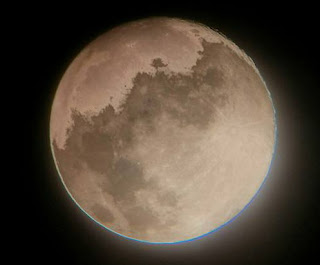Location: Lepreau, NB, Canada
Date Time: July 12, 2015 2130-0000hrs AST
Weather: No wind, lots of dew, lots of mosquitoes, kind of hazy with lots of moisture in the air but no clouds 20C at 2120hrs, 10C at 0000hrs.
Attendance: Myrtle, Ed O, Stephen T, and Myself. All of us are members of the Saint John Astronomy Club.
Equipment: Stephens' 20" dobsonian with 25mm and 8mm eyepieces, stepladder to reach eyepiece which was over 6 ft off the ground. A laser pointer.
My Canadian Telescopes 80 ED/APO on an Alt Az mount with 12 and 6mm eyepieces, with a Rigel red circle finder.
Objective: To view celestial objects through Stephens 20" telescope, known as Big Ass, then compare to images seen through my smaller scope.
Highlights: Four double stars, four Messier objects, two Planets, one Iridium Flare, over a dozen satellites and a kind of faint Milky Way...all in a little over an hour of dark, hazy sky. Its truly an amazing experience to observe the sky with people who have decades of observing experience and knowledge. They just seem to know where so many things are, without having to do the exhaustive search.
Report: The big talk on this evening was the condition of the sky for viewing. It was less than ideal with the amount of moisture in the air.
Saturn, located west of Antares, in Scorpius, was viewed in both scopes with the rings and Titan visible in the 80 ED/APO. Myrtle commented on how the ringed planet appeared at a strange angle in the eyepiece, compared to the big scope. Stephen said that the two scopes invert the image differently.
The big scope, operated by Ed, had a view of Saturn that was amazing, if a little fuzzy possibly due to moisture in the atmosphere. With the 8mm eyepiece, Ed saw the Cassini division, while I seen a storm band across the surface of the huge planet.
The double star Zubenelgenuby was viewed through the 80 ED/APO. Myrtle commented how one star was brighter than the other.
The other bright star in Libra the Scales, was also viewed through my scope. I see this star as green, whereas Stephen and Myrtle seen it as bluish.
I viewed Antares through my scope and was amazed at how it sparkled like three rotating red fireballs. Used Antares to locate the globular cluster M4. Its only one circle length in the Rigel finder to the west. It was a faint smudge in my scope, even at the highest power. Its too low on the horizon for good, clear viewing.
Polaris was viewed in my scope, but this double star could not be split, even with the 6 mm eyepiece.
Mizar and Alcor were viewed in my scope. There is a bunch of stars in the field of view, with one pair being very close together. A very interesting view.
Albireo was viewed in both scopes with the signature Red and Blue stars shining hugely in Big Ass. Always a treat to view.
Ed found M13, almost straight up at around 2330hrs. It was massive in Big Ass. To me it looked like a fireworks display frozen in time against a reddish backdrop. Ed saw diamonds on black velvet.
Ed found M57 in Lyra, then showed me how to find it with a laser pointer. Amazing detail within the smoke circle could be seen as well as the central star with the big scope. I was able to find it on my own, with the small scope, thanks to Eds' advice . It showed up as a faint smoke circle.
Ed also found M51, just below the end of the handle of the Big Dipper, which was in the NW at around 2340hrs. I could see two galaxies and could faintly see hints of the spiral arms.
Over a dozen satellites were seen. They seemed to be there every time one looked up. Many of them were heading from South to North. One very bright iridium flare was seen by Stephen, Ed and I, flying low just over the tree tops in the SW. It was easily brighter than Venus for a few seconds.
No Shooting stars were seen.
Images: No images taken on this evening. It was all about locating, viewing and discussing celestial objects with fellow astronomy enthusiasts.

























